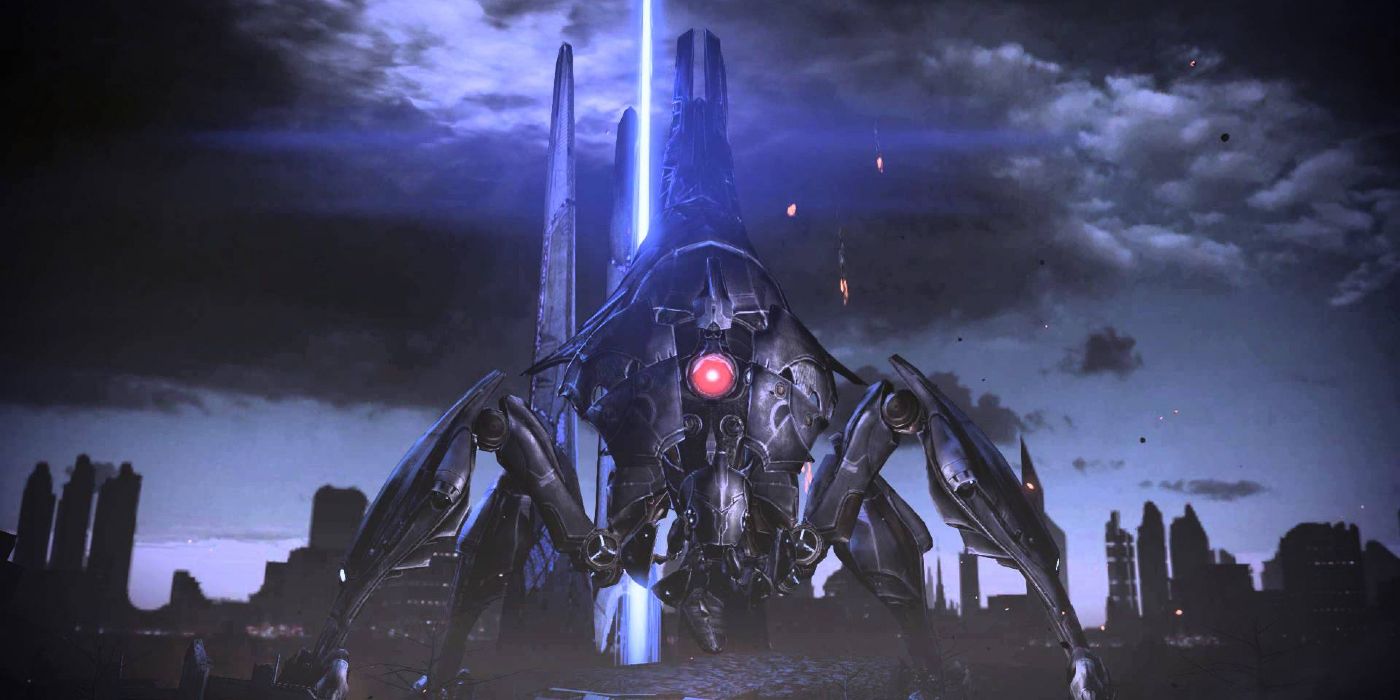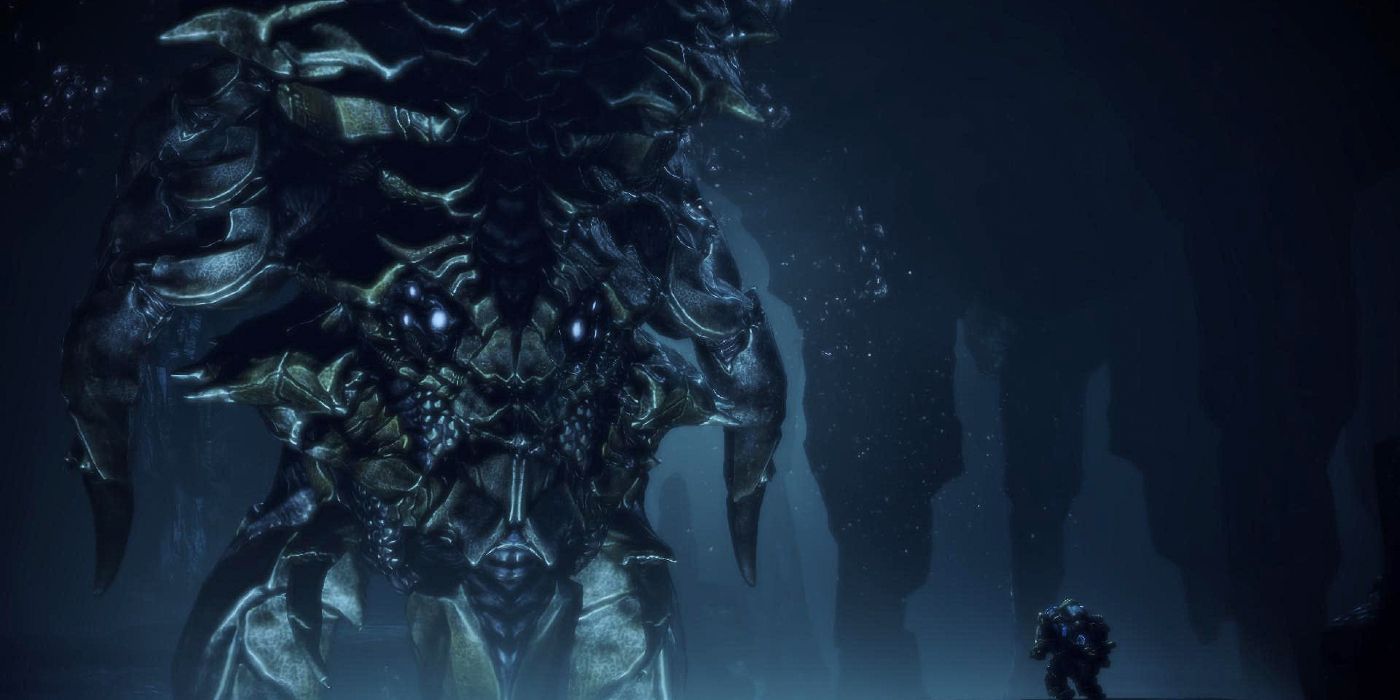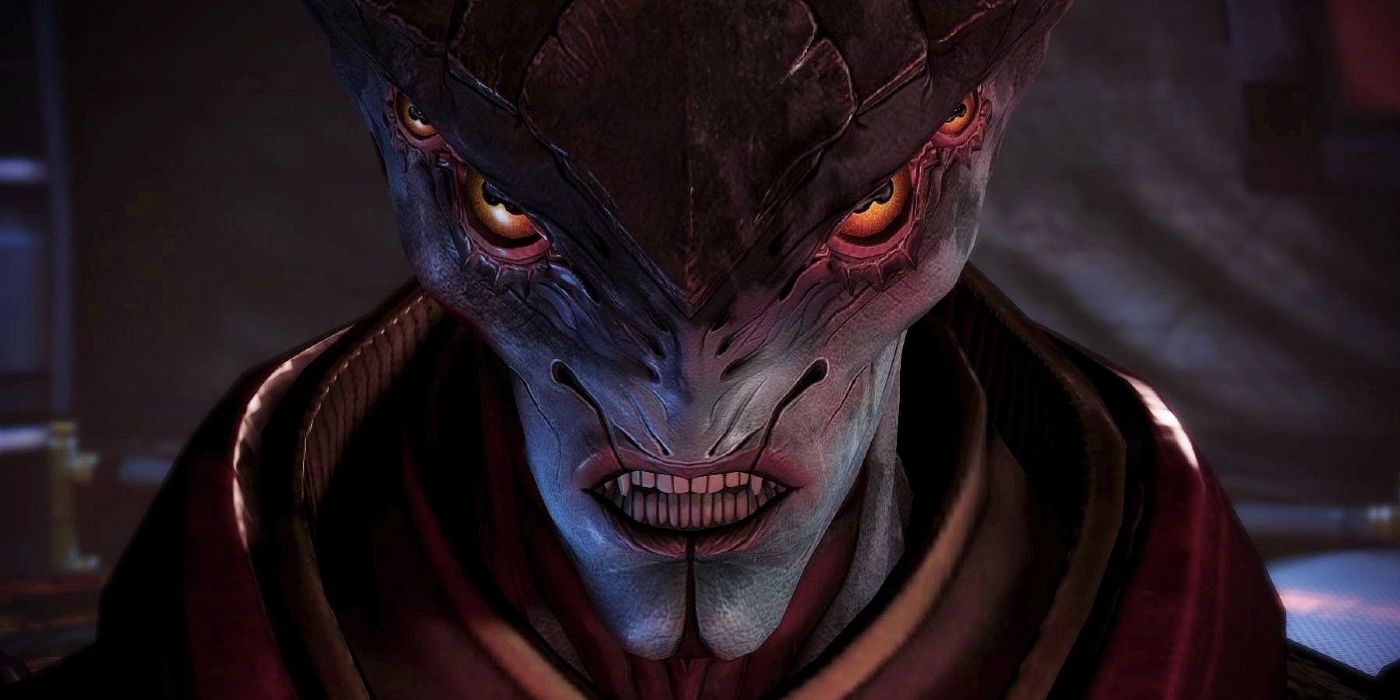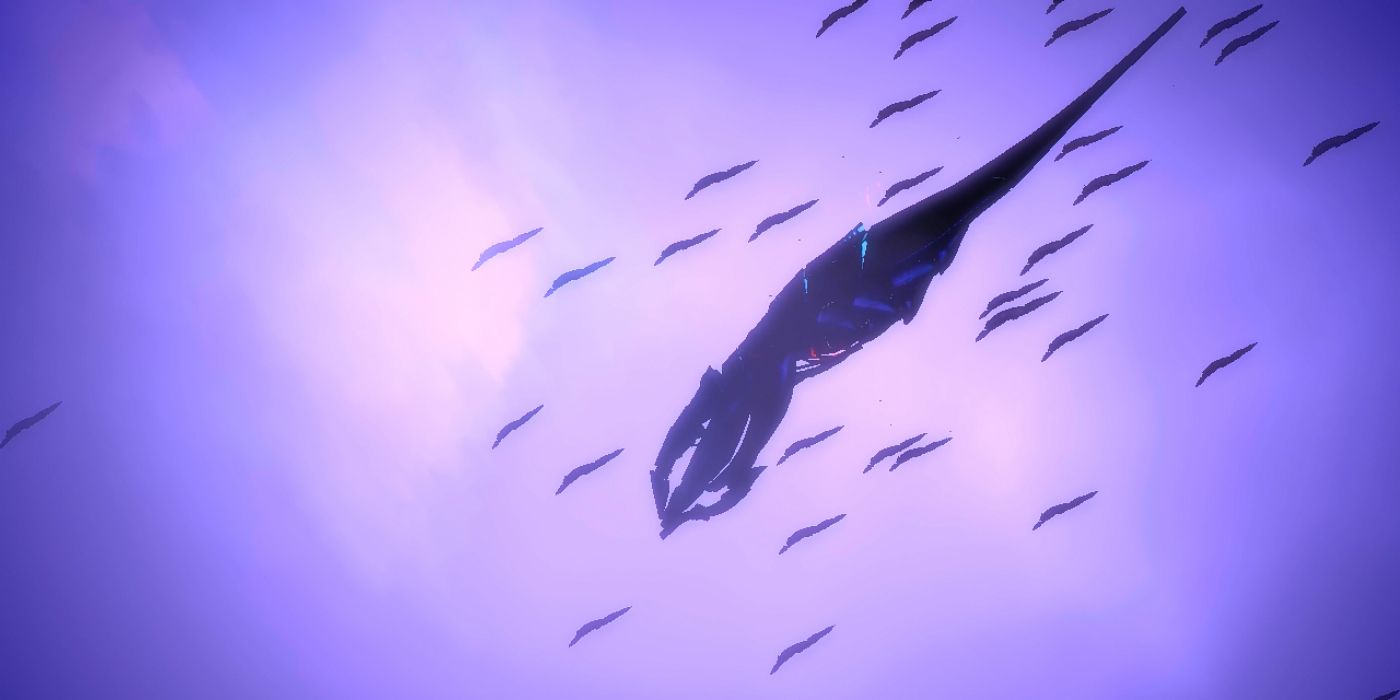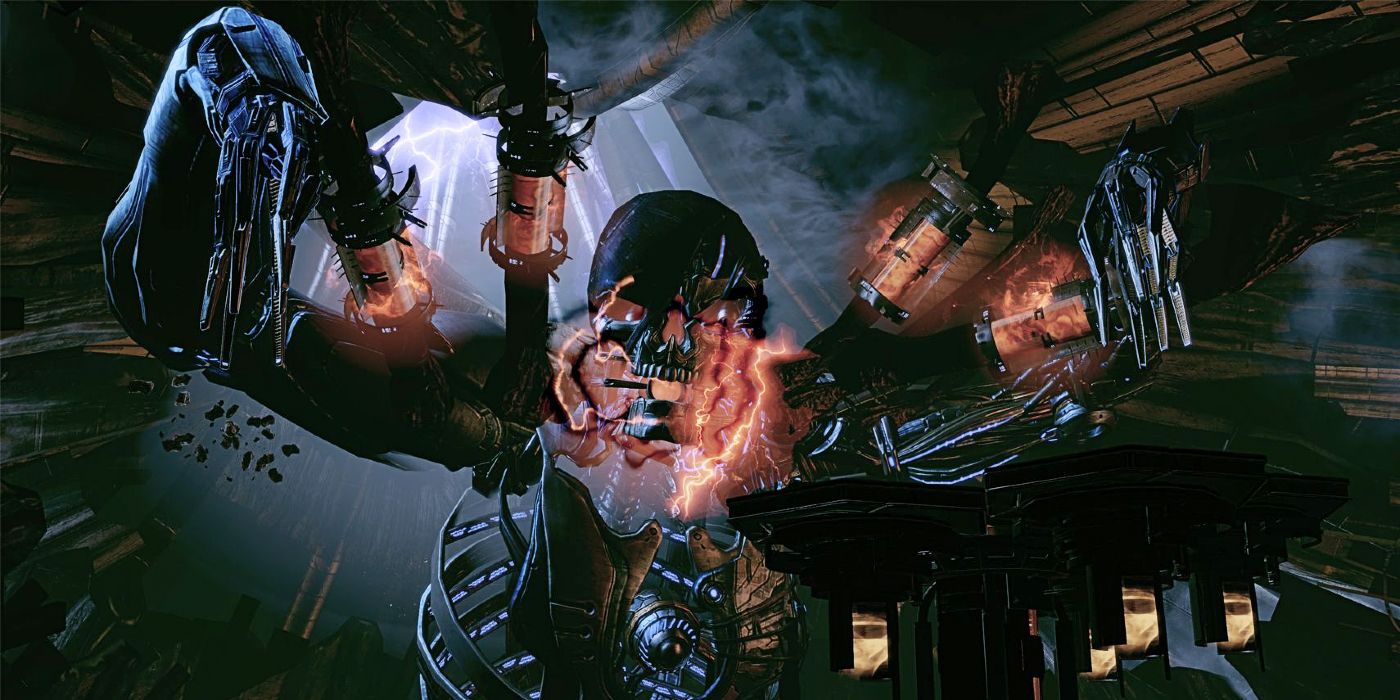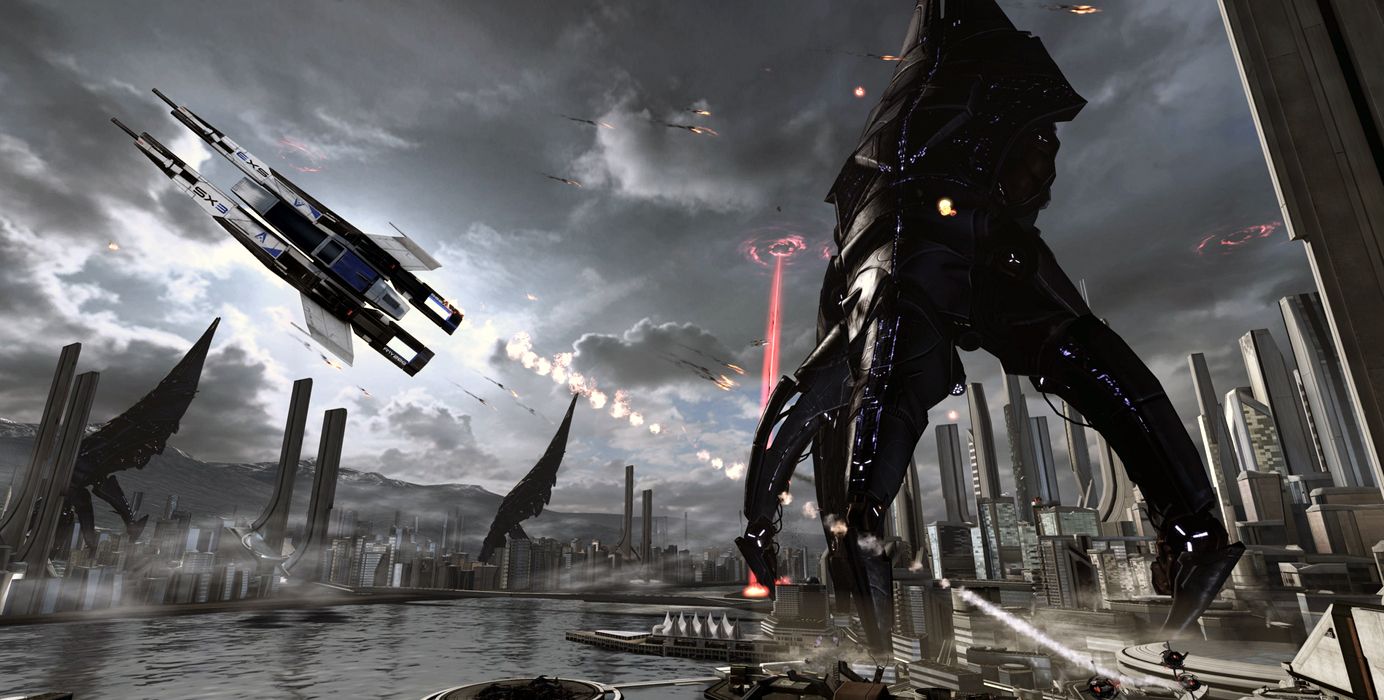Like many works of science fiction, Mass Effect focuses heavily on a conflict between organic and synthetic life. Sentient machines and artificial intelligence abound in the Mass Effect universe, usually to the detriment of their creators or others. The overarching narrative of the original trilogy itself centers around the invasion of an all-powerful machine race known as the Reapers, even though they don't appear in large numbers until the third Mass Effect game.
An ancient and looming threat for most of the trilogy, Mass Effect's Reapers seek to destroy all life in the Milky Way Galaxy for reasons unknown to the interstellar races currently facing the threat of extinction. The existence of the Reapers begins nearly one billion years in the past, and their machinations are uncovered throughout the events of all three Mass Effect titles by Commander Shepard.
The following history of the Reapers in Mass Effect will necessarily contain spoilers, so those looking forward to playing the series for the first time when the remastered Legendary Edition comes out might want to avoid reading too far ahead. At the very least, bow out before the section dealing with the Reapers' involvement in the first Mass Effect, since the section regarding their origins will have some interesting background information and only reveal the big-picture concepts behind the series' main group of antagonists.
Mass Effect: The Origin of the Reapers
In an incredibly ancient era of the Milky Way, roughly one billion years before the events of Mass Effect 1, the galaxy was ruled by an advanced alien race known as the Leviathans. Though originally an aquatic race, the Leviathans achieved spaceflight and claimed dominance over all other sapient species by enthralling them and subjugating them with a demand of tribute in exchange for protection. The Leviathans' reign lasted for an unknown amount of time, but an observed pattern emerged in which the subjugated species repeatedly brought about their own destruction through technological singularity. A machine race would be created to serve as a labor force, and subsequently rebel against its creators.
In an ultimate act of hubris, not realizing they would fall victim to the same cycle, the Leviathans design an artificial intelligence to solve the problem and preserve all forms of life. This AI, known as The Intelligence, came to the conclusion that organics created synthetics in order to improve their existence, but in order for the synthetics to become the ultimate tool, they would have to surpass their creators. In one way or another, the attempt by synthetics to evolve to a higher form resulted in the violent destruction of the organic race.
In order to fulfill its prime directive, the Intelligence decided organic life must be harvested for the sake of preservation before it is allowed to create a subjugated synthetic race. Thus, the first victim of the harvest would be the Leviathans, who created the Intelligence to improve their own existence. The Intelligence constructed the first bio-synthetic Reaper named Harbinger in the Leviathans' image, a design that all subsequent Reapers would mimic with variations.
The Milky Way then became the repeated staging ground for The Intelligence's preservation efforts. Every 50,000 years or so, after interstellar life had evolved, the Reapers would return to harvest all organic matter. The destruction of advanced races would then give new life room to evolve. The harvest cycle happened an unknown number of times before the one which concludes in the Mass Effect trilogy.
Mass Effect: Early Attempts to Destroy the Reapers
Many galactic communities fought in defiance of the Reapers' harvests, though the destruction wrought by the living machines was so thorough hardly any evidence of such struggles survived. One unknown race managed to leave a mark on the galaxy 37 million years ago, killing a Reaper in the process. They used a mass accelerator to decimate a single Reaper, and the projectile impacted a planet called Klendagon after destroying its target. Commander Shepard would later go on an important mission in Mass Effect 2 to the derelict Reaper corpse that was left behind.
In the harvest cycle prior to the one concerning Humans and their fellow interstellar races in the original Mass Effect, a technologically advanced species known as the Protheans attempted to thwart the Reaper invasion. The Protheans created a vast empire in the Milky Way, and engaged in a war with the Reapers for centuries. The Reapers were ultimately victorious, however, and the Protheans were rendered extinct. Prothean ruins are later found throughout the Milky Way, including on Mars, where the discovery shepherded the Human race into the interstellar era.
Reaper Involvement in the Events of Mass Effect 1
Only one Reaper, known as Sovereign, appears in the first Mass Effect. Sovereign has indoctrinated the rogue Spectre Saren in order to help facilitate the next harvest. A radical, separatist sect of Geth known as Heretics have also joined Sovereign, acting as a military in exchange for advanced Reaper technology. Sovereign's main goal is to reach the Citadel, a space station used as the seat of power for nine of Mass Effect's races.
The Citadel, once thought to have been built by the Protheans, is actually a disguised Mass Relay built by the Reapers. Commander Shepard makes this discovery thanks to a Prothean virtual intelligence (VI), which informs the Commander that the entire Mass Relay network is an elaborate trap designed to accelerate the galactic expansion of intelligent species. The Citadel is strategically designed and placed to become a crucial fixture in galactic society, thus making the Reaper invasion easier as an ingress point.
Thanks to a miniature Mass Relay called the Conduit, which was built by the Protheans to connect the planet Ilos to the Citadel, Shepard is able to follow Saren to the Citadel's control console and stop him before the Mass Relay can be activated. Sovereign and the Heretic fleet are eventually destroyed by Alliance forces at the conclusion of Mass Effect 1.
Reaper Involvement in the Events of Mass Effect 2
With their plan to use the Mass Relay in the Citadel thwarted, the Reapers must begin acting from afar. Taking interest in Humans for their genetic diversity and because it was a Human that lead to the destruction of Sovereign, the Reapers begin attacking human colonies with a race of genetically altered Prothean drones called Collectors. The Reapers get revenge in the opening scene of Mass Effect 2 by destroying the Normandy SR-1 and killing Shepard with a Collector ship. The Collectors are under the direct control of Harbinger, the original Reaper, and operate from an inaccessible base near the galactic core.
The Collectors attack Human colonies and take prisoners in order to harvest their genetic material in an effort to build a Reaper in the likeness of a Human. The Illusive Man, head of human-first terrorist organization Cerberus, recovers Shepard's body, revives them, and builds the Normandy SR-2 so Shepard can address the Collector threat. Shepard eventually manages to retrieve a Reaper IFF, which lets the Normandy pass through the Omega-4 Relay and infiltrate the Collector base.
The Collectors had not yet finished construction of the Human Reaper, and only its head, torso, and arms were completed when Shepard arrives to destroy it. After the conclusion of Mass Effect 2's suicide mission, the Reapers are seen activating in dark space outside the Milky Way and beginning their invasion.
Reaper Involvement in the Events of Mass Effect 3
The Reaper invasion of the Milky Way is the main focus of Mass Effect 3. The game opens with a Reaper fleet landing on Earth and the Alliance initiating a retreat. As the Reapers target the major centers of civilization on each of the races' home worlds, they begin indoctrinating the local populations, turning organic beings into bio-synthetic husks used as foot soldiers. Designs for an ancient, Reaper-destroying weapon known as the Crucible are discovered in the Prothean ruins on Mars. Constructing the Crucible becomes a key objective of Commander Shepard and the Alliance.
The organic species are not the only ones affected by the Reaper invasion - the fate of Mass Effect's Geth becomes a focal point in the midst of the war. In a bid to secure more troops, the Reapers make another deal with the Geth, promising advanced weaponry so the Geth can defend themselves from their Quarian creators, who are attempting to reclaim their home world Rannoch.
Thanks to another Prothean VI discovered in an artifact on the Asari home world Thessia, it is learned that the final component for the Crucible is something called the Catalyst, which is located on the Citadel. The VI was taken by the Illusive Man, who was seeking a method of controlling the Reapers, but he is eventually indoctrinated and the location of the Catalyst is revealed. In a move to protect the Citadel, the Reapers reposition the space station into orbit around Earth, which has almost entirely fallen under Reaper control.
Shepard manages to make it aboard the Citadel during Mass Effect 3's final battle via a teleportation beam linking the space station to Earth's surface. There the Commander discovers that the Catalyst is actually the Intelligence, which notes that completing the Crucible has effectively made the harvesting cycle obsolete. The fate of the Reapers, along with that of all life in the galaxy, is left up to Shepard, who has three options: destroy the Reapers along with all synthetic life in the galaxy; control the Reapers by transferring their own consciousness into the Crucible; or synthesize the Reaper's bio-synthetic anatomy with the genetic make-up of all the galaxy's life forms, causing every species to become a hybrid.
Alternatively, Shepard may choose to reject the notion of making such a massive decision, resulting in a successful harvest. No matter Shepard's choice, the Reaper invasion effectively ends. The mysterious, powerful antagonists of the Mass Effect trilogy have their billion-year-long history reach its current conclusion along with the trilogy's close. However, it remains to be seen if the Reapers will have some sort of role in the upcoming sequel to the original ME trilogy.

